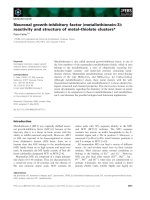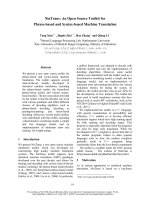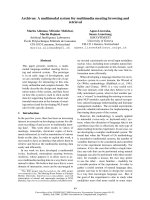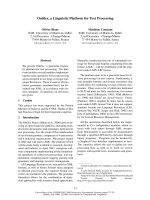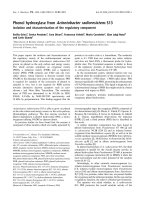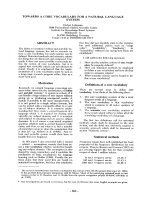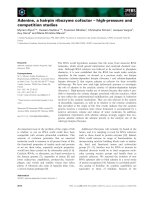báo cáo khoa học: " NorthStar, a support tool for the design and evaluation of quality improvement interventions in healthcare" ppt
Bạn đang xem bản rút gọn của tài liệu. Xem và tải ngay bản đầy đủ của tài liệu tại đây (511.9 KB, 7 trang )
BioMed Central
Page 1 of 7
(page number not for citation purposes)
Implementation Science
Open Access
Research article
NorthStar, a support tool for the design and evaluation of quality
improvement interventions in healthcare
Elie A Akl*
1
, Shaun Treweek
2
, Robbie Foy
3
, Jill Francis
4
, Andrew D Oxman
5
for the ReBEQI group
6
Address:
1
Department of Medicine, State University of New York at Buffalo, USA,
2
Tayside Centre for General Practice, Community Health Sciences
Division, University of Dundee, UK,
3
Centre for Health Services Research, Newcastle University, UK,
4
Health Services Research Unit, University of
Aberdeen, UK,
5
Norwegian Knowledge Centre for the Health Services, Oslo, Norway and
6
Research-Based Education and Quality Improvement,
European partnership
Email: Elie A Akl* - ; Shaun Treweek - ; Robbie Foy - ;
Jill Francis - ; Andrew D Oxman -
* Corresponding author
Abstract
Background: The Research-Based Education and Quality Improvement (ReBEQI) European
partnership aims to establish a framework and provide practical tools for the selection,
implementation, and evaluation of quality improvement (QI) interventions. We describe the
development and preliminary evaluation of the software tool NorthStar, a major product of the
ReBEQI project.
Methods: We focused the content of NorthStar on the design and evaluation of QI interventions.
A lead individual from the ReBEQI group drafted each section, and at least two other group
members reviewed it. The content is based on published literature, as well as material developed
by the ReBEQI group. We developed the software in both a Microsoft Windows HTML help
system version and a web-based version. In a preliminary evaluation, we surveyed 33 potential
users about the acceptability and perceived utility of NorthStar.
Results: NorthStar consists of 18 sections covering the design and evaluation of QI interventions.
The major focus of the intervention design sections is on how to identify determinants of practice
(factors affecting practice patterns), while the major focus of the intervention evaluation sections
is on how to design a cluster randomised trial. The two versions of the software can be transferred
by email or CD, and are available for download from the internet. The software offers easy
navigation and various functions to access the content. Potential users (55% response rate)
reported above-moderate levels of confidence in carrying out QI research related tasks if using
NorthStar, particularly when developing a protocol for a cluster randomised trial
Conclusion: NorthStar is an integrated, accessible, practical, and acceptable tool to assist
developers and evaluators of QI interventions.
Published: 26 June 2007
Implementation Science 2007, 2:19 doi:10.1186/1748-5908-2-19
Received: 1 August 2006
Accepted: 26 June 2007
This article is available from: />© 2007 Akl et al; licensee BioMed Central Ltd.
This is an Open Access article distributed under the terms of the Creative Commons Attribution License ( />),
which permits unrestricted use, distribution, and reproduction in any medium, provided the original work is properly cited.
Implementation Science 2007, 2:19 />Page 2 of 7
(page number not for citation purposes)
Background
Clinical evidence is essential to enhance the delivery of
care and improve patient outcomes. Yet the transfer of
research findings into clinical practice tends to be a slow
and haphazard process. One of the central aims of quality
improvement (QI) activities is to enhance such transfer.
In spite of the growing body of rigorously conducted stud-
ies on the effectiveness of various QI strategies [1], the
strategies selected for QI activities tend to be based more
upon prevailing disciplinary customs and habits than sci-
entific evidence and explicit rationales [2,3].
In 1999, the European Commission (EC) published a
report that considered various ways to improve the effec-
tiveness and efficiency of European health care systems
[4]. The report recommended work to inform strategies
for the effective dissemination and implementation of
research findings. The Research-Based Education and
Quality Improvement (ReBEQI) project was developed to
improve QI research and practice, and respond to the EC
recommendations [5]. The project group comprised seven
partners in six European countries (Appendix, see Table
4), each with substantial experience in QI research [6].
The project took place over three years (December 2002 –
November 2005) and was funded by the European Com-
mission's Quality of Life and Management Living
Resources 5 th Framework Program. The ReBEQI project
had two objectives:
1. To establish a framework for the selection, implemen-
tation, and evaluation of interventions to promote evi-
dence-based clinical practice.
2. To provide clinicians, policy-makers, and researchers
with a suite of evidence-based, Internet tools, guided by
the framework, to inform the development and evalua-
tion of interventions to promote evidence-based clinical
practice.
NorthStar is a major product of the ReBEQI project. It is a
software program that packages information on the
design and evaluation of evidence-based QI interventions
into an integrated, easily accessible, and practical tool. In
this paper, we provide a general overview of the guiding
principles, content development and software develop-
ment of NorthStar and report its preliminary evaluation.
We refer readers to the ReBEQI website for further infor-
mation on ReBEQI and to see the NorthStar content in
full [5].
Methods
Guiding principles
The development of NorthStar was guided by four princi-
ples. First, the information and tools it offers need to be
evidence-based, while being explicit about the limitations
of existing evidence. For example, whilst there is a grow-
ing body of evidence on the effectiveness of various QI
interventions, it is recognised that no single intervention
will be consistently effective across a wide range of prob-
lems and contexts [1]. Second, NorthStar has to be appro-
priate to the diverse needs of its target audience, who may
have varying levels of skills and experience in quality
improvement and research. Third, NorthStar has to be
simple to read and navigate to ensure its relevance, accept-
ability and usefulness.
Content development
The target audience of the tool include QI researchers,
healthcare professionals and managers responsible for
developing, delivering and evaluating continuing educa-
tion (CE) and QI programmes at a national or regional
level. Consequently, the two areas we covered were the
design of QI interventions and their evaluation. The
intention was for the tool to be useful to users with vary-
ing levels of experience in QI research, and for the text to
be instructional as well as informative. For example, when
describing the different types of cluster, randomised con-
trolled trials (cluster RCTs), in addition to outlining the
features of each type, the text would guide the user with
regard to when the use of each design might be appropri-
ate.
A lead individual from the ReBEQI group was identified
for each section of the tool according to individual exper-
tise. This lead person took responsibility for preparing the
first draft of that section, based on a review of the pub-
lished literature as well as other outputs of the ReBEQI
project (e.g. a literature review of QI models and frame-
works). At least two other ReBEQI members reviewed the
section. An editor ensured that the different sections were
consistent with regard to content, structure and writing
style. All group members reviewed the final version for
wider feedback and final approval.
The content builds on the framework developed by
ReBEQI for the selection, implementation and evaluation
of QI interventions. It guides the user on how to identify
"determinants of practice" in designing the intervention
and on how to design a cluster RCT as the preferred eval-
uation study design. Determinants of practice are the fac-
tors that affect practice patterns and explain the variation
in the effectiveness of different QI interventions in chang-
ing practice patterns; they are usually categorized as "bar-
riers and facilitators" or as "moderators and mediators"
[7,8]. The NorthStar section on cluster RCTs is based, in
part, on the Trial Protocol Tool, a product of the Prag-
matic Randomized Controlled Trials in HealthCare
(PRACTIHC) group [9].
Implementation Science 2007, 2:19 />Page 3 of 7
(page number not for citation purposes)
Software development
We developed NorthStar as a Microsoft Windows HTML
help system, the standard help system used with Windows
95 and above. This choice gives the tool a familiar Win-
dows interface and provides a range of off-the-shelf func-
tionality. The software for running Windows HTML help,
including Internet Explorer upon which it relies, is part of
the Windows operating system. The basic HTML help
development tool, Microsoft HTML Help Workshop, is
available free from Microsoft's website. We also created a
web-based version using chm2web by A!K Research Labs
[10] that is platform-independent and works with any
modern browser.
For the content, we created HTML versions of Word docu-
ments using Mozilla 1.4 for Mac OS X. We then linked the
HTML documents to the help system in HTML Help
Workshop. The HTML documents can contain links to the
full spectrum of electronic document formats and can,
therefore, include not only textual information but graph-
ics, documents created by other programs, sound, video,
as well as links to websites and other programs. Once the
HTML documents have been added or updated, the col-
lection is compiled into a single file (a .chm file). The
compiled .chm file included the main text of NorthStar,
while accompanying documents such as pdf or Word files
were organized as external files in the same folder as the
compiled .chm file.
Preliminary evaluation
We undertook a questionnaire survey of two groups of
potential NorthStar users. The first group comprised eight
postgraduate students attending a research methodology
course in Göteborg, Sweden. The course focused on the
planning of intervention studies within the broader con-
text of health systems research. The second group con-
sisted of 25 individuals, nominated by the seven ReBEQI
partners, responsible for developing, delivering, and/or
evaluating CE and QI activities. Most of them were based
in the ReBEQI partner countries. We surveyed the first
group during a class session in 2006, and contacted the
second group by e-mail during 2005–2006. We sent non-
responders one e-mail reminder two weeks after the initial
contact.
We asked respondents to spend around twenty minutes
browsing NorthStar (with no constraints to the browsing
sequence) and to fill out a questionnaire. First, we asked
respondents about their main professional roles, their
roles in CE and QI, and their experience in QI research.
We then asked them to estimate the time spent browsing
NorthStar and which sections they reviewed the longest.
We also asked respondents to use a seven-point scale (1
representing 'not at all,' and 7 'a lot.') to rate their level of
confidence with the use of NorthStar, and in carrying out
10 named tasks relevant to QI research. A final question
requested open-ended feedback on the format and user-
friendliness of NorthStar. A copy of the questionnaire is
available as an Additional File. We used descriptive statis-
tics to report aggregated responses from the two groups
because of the relatively small number of participants
from each.
Results
NorthStar Content
NorthStar consists of 18 sections covering the design and
evaluation of QI interventions. After two introductory sec-
tions (About NorthStar and Introduction), NorthStar dis-
cusses how to involve stakeholders (Stakeholder
Involvement). It then examines how to identify and select
priorities in order to use resources efficiently (Priority Set-
ting). Next, it provides guidance on how to identify, criti-
cally appraise, adapt, and develop relevant clinical
practice guidelines (Clinical Practice Guidelines). It also
discusses the why, what and how of measuring baseline
performance defined as the measurement of actual clini-
cal practice and its comparison to desired clinical practice
(Measuring Baseline Performance).
NorthStar discusses what the determinants of practice are
and how to identify them using both explorative methods
and theory-based methods (Identifying Determinants of
Practice). It then provides guidance on what intervention
strategy to use, and how to select determinants of practice,
and use them to tailor the intervention (Designing the
Intervention).
NorthStar assists the user in the choice of appropriate
study design to test the QI intervention (Choosing the
Study Design). It then discusses the usefulness, limita-
tions, and types of pilot studies (Pilot Studies). The major
section of NorthStar is dedicated to the development of
protocols for cluster RCTs (Cluster RCT Protocol Tool).
Next, it examines when to use and how to design an inter-
rupted times series evaluation (Interrupted Time Series
Evaluation). NorthStar reviews two other types of evalua-
tion (Process Evaluation and Economic Evaluation). It
also provides guidance on how to form or identify net-
works of QI researchers, health professionals, health serv-
ice managers, and policy makers (CE and QI programs).
Finally NorthStar provides useful resources (Glossary,
Libraries and Web Resources). Table 1 shows the general
outline of each of these sections.
NorthStar software
NorthStar is available as an HTML Help system, or as a
browser-based version. Figure 1 shows a sample screen-
shot from the browser-based version of NorthStar. Both
versions can be transferred by e-mail and on CD, and
downloaded from the Internet [11]. Once downloaded,
Implementation Science 2007, 2:19 />Page 4 of 7
(page number not for citation purposes)
neither version of NorthStar requires an Internet connec-
tion for use, although links to websites do require a live
Internet connection. The July 2006 version of the tool
comprises a compiled .chm file (808 kB), an external set
of libraries (9.2 Mb), and a collection of other supporting
external material (6.8 Mb). Most of the main sections of
NorthStar also are being translated into French and Italian.
The user can access the content of NorthStar in many dif-
ferent ways:
1. Contents: An outline at the left helps the user to locate
what he/she needs. "Books" (each containing one of the
18 sections described above) can be expanded or col-
lapsed by clicking on the +/- sign to the left of the book
symbols.
2. Search: The user can search for words anywhere in the
text.
3. Hypertext: The hypertext links help to navigate North-
Star, for example by bringing up relevant definitions or
explanations in the glossary, examples or illustrations.
4. Print: Selecting 'Print' in the browser or from the Win-
dows Help system will print the contents of the main
NorthStar window.
5. Libraries: These can be accessed from the 'Libraries'
menu at the top of the screen or from the bottom of the
contents and include: checklists, an annotated bibliogra-
phy of key methodological papers, structured abstracts of
selected references, summaries of key theories, and exam-
ples of protocols and final reports of evaluations of QI
interventions.
NorthStar preliminary evaluation
Eight participants from the student group and ten from
the ReBEQI nominees responded to the survey (total
response rate 18/33; 55%). One respondent from the
ReBEQI group provided free text responses only, so we
included only 17 responses in the quantitative analysis.
Fourteen (82%) respondents described themselves as
health care researchers; others were health care practition-
ers and managers. Nine (53%) reported intermediate lev-
els of experience in QI research compared with seven
(41%) who described themselves as either beginners or
having no role in QI research and one (6%) experienced
QI researcher. The mean time spent browsing NorthStar
was 20.6 minutes. Participants spent most of the time
looking at 'Identifying Determinants of Practice' (8/17;
47%) and 'Designing the Intervention' (6/17; 35%). The
levels of confidence in carrying out, with the use of North-
Star, the ten tasks related to QI research, were all above the
Table 2: Respondents' self-rated confidence in carrying out tasks relevant to quality improvement research using NorthStar.
Task Mean (range)
Involve stakeholders in quality improvement intervention research 4.9 (3–7)
Identify and select priorities in order to use resources efficiently 5.2 (4–6)
Critically appraise clinical guidelines 5.1 (4–7)
Measure baseline performance (defined as the measurement of actual clinical practice and its comparison to desired clinical
practice)
4.9 (3–6)
Identify determinants of clinical practice 5.2 (4–6)
Decide what intervention strategy to use to improve the quality of care 5.4 (4–7)
Choose an appropriate study design to evaluate a continuing education or quality improvement strategy 5.5 (5–7)
Develop a protocol for a cluster randomised trial 5.7 (5–7)
Conduct a process evaluation 5.2 (4–6)
Design an interrupted time series evaluation 5.1 (4–6)
*Based on a 1–7 scale where 1 = not at all confident and 7 = very confident
Table 1: The general outline of NorthStar sections
This section contains the following An outline of the section
Introduction One or two paragraphs introducing the topic
Things to consider Checklists; background information; protocol considerations (relating to writing the trial protocol); and
practical considerations (relating to implementing the intervention)
Illustrative examples Examples taken from protocols or final reports of cluster RCTs of QI interventions. They show either
different aspects of the topic or how different studies addressed the same aspect
References Journal articles or books referenced in the text
Resources Useful documents (accessible directly in NorthStar), links to websites, software, and recommended
further reading (brief and sometimes annotated bibliography of key references)
Implementation Science 2007, 2:19 />Page 5 of 7
(page number not for citation purposes)
mid-point of the scale (i.e., four; Table 2). Respondents
indicated the greatest confidence in being able to develop
a protocol for a cluster randomised trial (mean 5.7) and
the least confidence in being able to involve stakeholders
in QI research and measuring baseline performance (both
means 4.9).
Respondents generally made positive comments about
the format and user-friendliness of NorthStar (illustrative
comments in the Table 3). Some also mentioned technical
problems around its use, while others questioned its
major focus on RCTs as the 'gold standard' method for
evaluating quality improvement strategies.
Discussion
NorthStar is a tool that aims to support the development
and evaluation of interventions to improve the quality of
healthcare. Its target audience includes QI researchers,
healthcare professionals, and managers responsible for
developing, delivering and evaluating CE and QI pro-
grammes at a national or regional level.
NorthStar has a number of strengths. The work reflects the
collective experience of several established European
inter-disciplinary collaborations, but also is based on
recent literature reviews and the ReBEQI group's own
innovative methodological work. The development of the
content employed iterative processes of drafting, review-
ing and editing. The resulting content is simple to read,
pragmatic and focused on assisting the user in developing
and evaluating the QI intervention. In addition, NorthStar
is available as both a browser-based version and an HTML
help file version, and will soon be available in French and
Italian, as well as English. While the focus of NorthStar is
on QI programmes at a national or regional level, those in
charge of smaller-scale programmes (e.g. local QI initia-
tive) might also find selected components useful.
However, NorthStar has a number of limitations. Because
of the limitations of the existing evidence, many recom-
mendations within NorthStar are based on pragmatic
interpretations of that evidence. We used structured rather
than systematic reviews to draft sections – although these
drew upon systematic reviews. In addition, we do intend
to incorporate into NorthStar further evidence on the
effectiveness of QI strategies as it becomes available.
The results of our modest evaluation suggest that North-
Star will form a useful reference and educational tool for
QI research in general, and for developing a protocol for a
cluster randomised trial, in particular. Potential users
seemed mostly interested in the sections that identify
determinants of practice and the design of interventions,
which are both recognised as challenges requiring greater
attention in the implementation field [12]. However, our
evaluation of NorthStar was limited by a small sample
size, the limited representativeness of participants, the
lack of a comparison, and the assessment of intermediate
outcomes. For example, we have not evaluated the impact
of the use of NorthStar on the processes and outcomes of
development and evaluation of QI interventions. It also is
possible that actual or perceived technical barriers to
using NorthStar will discourage some potential users.
Conclusion
NorthStar is an integrated and practical tool to assist QI
researchers, healthcare professionals, and managers
responsible for developing, delivering and evaluating CE
and QI programmes at a national or regional level. Our
preliminary evaluation is broadly positive. In its current
form, NorthStar is mainly designed to meet the needs of
QI researchers.
Availability and Requirements
Project homepage
NorthStar is available from the 'Tools and databases'
menu.
Operating system
Windows HTML Help version works in Windows 95 and
above.
Table 3: Illustrative comments on user-friendliness, format and other features of NorthStar.
User-friendliness Very impressive in its scope and quality but it's not always clear who the audience for the tool is
It is indeed a very beautiful tool I found it user friendly, and particularly liked the sample-size calculation module for cluster randomization
Consider developing a more detailed tutorial (in parts) to walk individuals through how to use NorthStar to its fullest capability
My computer crashed twice when trying to access pdf files
Format [NorthStar] provides a clear overview, helps me think in a constructive and orderly fashion about what I need to do, and leaves me
inspired.
Content I can see the purpose in encouraging people as often as possible to conduct randomised trials of QI initiatives, but in fact most evaluation
will not be done in this way, and I'm not sure that those seeking to use NorthStar for the less rigorous designs will be well served
I think you risk misleading people with that stated aim [targeted at quality improvement researchers and healthcare professionals and
managers] – it looks great for researchers, but not for anyone else
Service quality improvers are unlikely towant to 'test' interventions in the formalsense, but they might want help with choosing
interventions and testing their effect in their own particular contexts
Implementation Science 2007, 2:19 />Page 6 of 7
(page number not for citation purposes)
Web-based system works with Linux, Mac OS 9/OS × and
Windows.
Other requirements
Windows HTML Help requires that Internet Explorer ver-
sion 3 or above is installed. The browser-based version
requires nothing more than a modern browser.
License
ReBEQI is happy to have its products used for personal
and non-commercial use and at no charge in free educa-
tional programmes. However, when tuition is charged,
ReBEQI royalty fee is 10% of gross receipts. If you are
planning to use NorthStar within a for-profit organisation
Screenshot from the browser-based version of NorthStarFigure 1
Screenshot from the browser-based version of NorthStar.
Table 4: Countries, partner organisations and partner managers of the ReBEQI project
France: Santé Publique et Informatique Médicale (SPIM), Faculté de Médecine Broussais – Hôtel Dieu, Paris. Partner manager – Pierrre Durieux
Italy: Unit of Clinical Governance, Agenzia Sanitaria Regionale (Regional Health Care Agency) of Emilia-Romagna, Bologna. Partner manager –
Roberto Grilli
Italy: Center for the Evaluation of Effectiveness of Health Care (Ce.V.E.A.S.), Modena. Partner manager – Alessandro Liberati
The Netherlands: Centre for Quality of Care Research, University of Nijmegen. Partner manager – Richard Grol
Norway: Norwegian Health Services Research Centre, Oslo. Partner manager – Andy Oxman
Sweden: Division of International Health, Department of Public Health Sciences, Karolinska Institutet, Stockholm. Partner manager – Cecilia
Stålsby Lundborg
United Kingdom: Centre for Health Services Research, University of Newcastle, Newcastle. Partner manager – Martin Eccles
Publish with Bio Med Central and every
scientist can read your work free of charge
"BioMed Central will be the most significant development for
disseminating the results of biomedical research in our lifetime."
Sir Paul Nurse, Cancer Research UK
Your research papers will be:
available free of charge to the entire biomedical community
peer reviewed and published immediately upon acceptance
cited in PubMed and archived on PubMed Central
yours — you keep the copyright
Submit your manuscript here:
/>BioMedcentral
Implementation Science 2007, 2:19 />Page 7 of 7
(page number not for citation purposes)
in any way, please contact us to discuss a donation to our
work.
Competing interests
The author(s) declare that they have no competing inter-
ests.
Authors' contributions
All authors participated in the development and evalua-
tion of NorthStar. EAA and RF were the content editors. ST
was responsible for the technical development of North-
Star. ADO was the central coordinator of the project. All
authors read and approved the final manuscript.
Acknowledgements
The ReBEQI project was funded by the European Commission 5th Frame-
work programme contract QLG4-CT-2002-00657. Some of the content
for the section 'Cluster RCT protocol tool' section was developed as part
of the Practihc project funded by the European Commission 5th Frame-
work programme contract ICA4-CT-2001-10019. We thank Dave Sackett
for contributing to the 'Cluster RCT protocol tool' section.
The ReBEQI partner managers are listed in the Appendix. A full list of indi-
viduals who have contributed to NorthStar is given in the Acknowledge-
ments page of NorthStar.
References
1. Grimshaw JM, Thomas RE, MacLennan G, Fraser C, Ramsay CR, Vale
L, Whitty P, Eccles MP, Matowe L, Shirran L, Wensing M, Dijkstra R,
Donaldson C: Effectiveness and efficiency of guideline dissem-
ination and implementation strategies. Health Technology
Assessment (Winchester, England) 8(6):iii-iv.
2. Grol R: Personal paper: Beliefs and evidence in changing clin-
ical practice. BMJ 1997, 315(7105):418-421.
3. Walker AE, Grimshaw J, Johnston M, Pitts N, Steen N, Eccles M:
PRIME - PRocess modelling in ImpleMEntation research:
selecting a theoretical basis for interventions to change clin-
ical practice. BMC Health Services Research 2003, 3:22.
4. Office for Official Publications of the European Communities: ‘Best
practice’: State of the art and perspectives in the EU for
improving the effectiveness and efficiency of European
health systems. Luxembourg , European Commission; 1999.
5. Research-based Education and Quality Improvement
(ReBEQI) [ />]
6. The ReBEQI group and project management [http://
www.rebeqi.org/ViewFile.aspx?itemID=70]
7. Grol R: Improving the Quality of Medical Care: Building
Bridges Among Professional Pride, Payer Profit, and Patient
Satisfaction. JAMA 2001, 286(20):2578-2585.
8. Johnston M, Eccles M, Pitts N, Grimshaw J, Steen N: Establishing a
scientific rationale for choosing interventions to translate
research findings into clinical practice: The PR1ME project.
[ />].
9. Treweek S, Abalos E, Campbell M, Ramsay C, McKormack K, Zwa-
renstein M: A software tool to support the writing of protocols
for pragmatic randomised controlled trials. Journal of Clinical
Epidemiology in press.
10. A!K Research Labs [ />]
11. Research-Based Education and Quality Improvement [http:/
/www.rebeqi.org]
12. Foy R, Eccles M, Grimshaw J: Why does primary care need more
implementation research? Family Practice 2001, 18:353-355.
